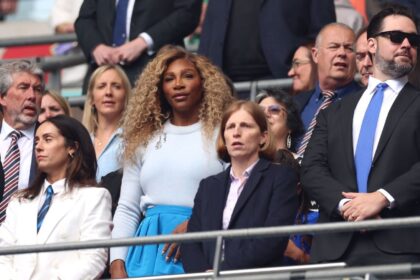On a warm Saturday in May, the prelude to the final day of the Eredivisie, the fields of VV Smitshoek, south of Rotterdam, are filled with activity. Children of all ages enjoy football, showing different levels of competitiveness.
Inside the facilities, a youth team celebrates their league victory, following the tradition of a french fry feast and a photo session with the trophy. The club has 1,275 members, with teams including players from 6 to 65 years old, with the older ones enjoying walking football on a field that was agricultural eight decades ago.
A short distance away, BVV Barendrecht is also in full swing. Its nine fields are packed, and the club hosts about 2,300 members. This is a small glimpse into the amateur football scene in the Netherlands, and it is in the suburbs of Rotterdam where Denzel Dumfries, right-back for Inter Milan and the Dutch national team, honed his talent.
Dumfries, 29, is preparing to play in the Champions League final with Inter Milan and, subsequently, the World Cup qualifiers in June. While his Dutch teammates were trained in academies from a young age, guided by the best minds in the sport, Dumfries, a decade ago, was just another kid enjoying football in this corner of the world, having been off the radar of the academies. He joined Smitshoek at the age of 7 and played there until he was 16, telling his teammates about his dream of playing for the Netherlands. Although they made fun of him, he never doubted himself. “He was a kid who really believed in his dream and was willing to do anything for it,” recalls Peter van der Pennen, his first coach at Smitshoek.It was through hard work in amateur football and immense self-confidence that he progressed to become one of the best full-backs in the world. But it all started in this corner of the Netherlands, in former farmland, just south of Rotterdam.
Peter van der Pennen

At the Barendrecht club, shirts of graduates like Dumfries, Anwar El Ghazi, and Finn Stokkers are displayed. Smitshoek, which also counts Fabian Wilnis and Dylan Vente among its alumni, has two Dumfries shirts in its boardroom, one from Inter Milan and another from PSV Eindhoven. In terms of 2025, it’s a unique case. “We often watched him, debated about him, but we didn’t think he was good enough,” commented Maup Martens, Feyenoord’s youth scout, in 2018. “There were too many doubts about his footballing qualities. Someone can be very physically strong at 15, but that advantage often disappears when they are 18.”
“It probably has to do with his technical qualities and his height at that time,” explains Van der Pennen, responding to those suggestions. “But he had other qualities that they ignored. He was fast and impressive. Every opponent feared him.”
Dumfries, named after Hollywood superstar Denzel Washington, played for Smitshoek from 2002 to 2013 (except for two years when he played for Spartaan’20, then returning to Smitshoek). Subsequently, he joined Barendrecht from 2013 to 2014.Dumfries’ room was in the attic of his parents’ house, and on the sloping walls he used to draw his starting eleven for the weekend’s match. “When we were training a specific skill and it didn’t work, he always wanted to repeat it until it worked,” recalls Van der Pennen. “He was also never satisfied when he was substituted; he always thought he was better than whoever replaced him. But with a face of few friends, he reluctantly reached the bench.”
Van der Pennen recalls a match in which they already had the championship secured, and were winning, but Dumfries was still chasing a lost pass. “He failed to keep the ball in play and fell to his knees, hitting the turf, even though the match was already easily won,” says Van der Pennen.“He was never a player like Messi, but he was always so sure of his own ability and confident that he would reach the top,” says Lesley Esajas, his coach at Barendrecht. “He was hyperactive, he never stopped running. If he took a corner, he would try to get into the area.”
Lesley Esajas
Dumfries used to regularly visit the Esajas’ house for dinner during the week, but Esajas remembers one day, at 17, when he refused the fries and mayonnaise, the usual Wednesday dish, as he had started to take nutrition seriously. “He said: ‘No, no, I need vegetables'”. His teammates at the time said that Dumfries skipped weekend parties, focusing on his fitness.
Jordi Dekker, coach of the Smitshoek U-14 team, played alongside Dumfries from the ages of 10 to 14. The team played with an offensive 3-3-4 formation, with Dumfries as a central defender.“There was a game where we were winning 5-4, and then they tied us at the end,” Dekker recalls. “Denzel was furious; he grabbed the other defender by the neck and crumpled his shirt.” On another occasion, at the age of 14, Dumfries wore an Ajax uniform in a training session, remembering that this is Feyenoord territory. Dekker adds: “His coach was not happy and told him to clean the training ground, but Denzel got on his bike and went home.”
In 2014, when Dumfries was 18, Sparta Rotterdam took a chance on him. (He also represented Aruba twice in friendlies against Guam). He played there in the reserves, where he learned from Champions League winner with Ajax and Dutch right-back, Michael Reiziger, before signing a professional contract. “He is much stronger than me and has much more lung capacity. He can go far,” Reiziger said at the time.Dumfries quickly attracted attention from other clubs. “He has many qualities to reach the top,” said Sparta coach Alex Pastoor at the time. “You just have to look at his physique. If you can play 80 times per half… those are things that ultimately make the biggest clubs in the world take notice of you.” Heerenveen signed him in 2017 for 750,000 euros. One season later, PSV paid 5.5 million euros for his transfer, which meant that both Barendrecht and Smitshoek earned 90,000 euros (compensation for the work done by amateur clubs for professional players). Smitshoek invested that profit in the renovation of their club.
Dumfries became captain of PSV. “Denzel wasn’t the player with exquisite technique, but he did have an iron mentality and perseverance,” says Van der Pennen. In 2021, Inter Milan signed him for 14.25 million euros. He has represented the Netherlands in two European Championships and in the 2022 World Cup, won the Scudetto with Inter Milan last year and helped the team reach the Champions League final this season, including two goals in the semi-final against Barcelona. But he has achieved all this despite the academy system, which guides and trains young players in a professional environment. Matthijs de Ligt trained at De Toekomst (the Ajax academy), where he received a full-time education and expert guidance on all facets of his development as a player. Meanwhile, Dumfries trained twice a week after school and played on Saturdays without help in nutrition and physical preparation, only with the knowledge of volunteer coaches who helped him.Dumfries himself said in a 2019 interview with Voetbal International: “People who didn’t see what I had, had a limited view. They only looked at me at that moment, but they should have looked further. They should have thought: ‘How can he develop?’. I think everyone should have that perspective, and not limit themselves to something so small.”
Dumfries still keeps his roots close. His parents live near Smitshoek. He works with Lesley Esajas’s brother, Errol, in movement training; Errol visits him in Milan every two weeks. Dumfries invited them to the Feyenoord-Inter Milan match as his guests, and to the return match in Milan. “He’s always working on himself,” says Esajas. “That’s why he made it.”
The day after his debut for the Netherlands against Germany in October 2018, he opened field number 9 in Barendrecht. After his under-16 team won the league this year, he sent a video message, wishing them the best in their careers. “I still get goosebumps watching him play,” says Esajas. “He did everything to be a star.”At the end of this season, 10 players between the ages of 9 and 17 will move from Barendrecht to professional clubs, with Sparta Rotterdam taking three. There are usually five scouts present at both Smitshoek and Barendrecht on Saturday mornings. They observe players as young as 6 years old, seeking to take them away from their friends and amateur teams to bring them to one of the professional teams in the Eredivisie. Both clubs have links with Feyenoord, but that doesn’t stop Sparta Rotterdam, Ajax, PSV, and many others from sending scouts to find the next star of the Netherlands.
It’s an arms race in football. Some scouts, according to sources, use unethical methods to circumvent the agreed-upon way of doing things, which states that they must first approach the club before talking to the parents to attract their children to their teams’ academies. But, of all these young talents, only a few will make it; many will be discarded. “The problem is that, with these young players, there is no natural progression: some peak early, others late,” says Leen Vos, facilities manager and interim head coach of Barendrecht’s youth academy. “They need space to grow.” Even then, with each group, scouts will overlook many of them in favor of playmakers. “These kids forget things like the importance of strength and a winning mentality,” says Esajas. “There are many players like Denzel out there, who just need time, but scouts won’t see it. They only look for players like Frenkie de Jong. Denzel needed space to do his thing.”
However, those who have witnessed Dumfries’ incredible late rise from the amateur ranks to the pinnacle of the Champions League, do not believe we will see someone like him again. The rush to get talented children into academies, and what they look for in them, means that Dumfries will remain an exception.
“Children don’t have the space they need to grow in football,” says Vos. “If they have technical talent, they will be taken to an academy, and then they will be in the system. Any misstep, and they’re out. If they have the physical attributes but not yet the skill, they will be lost. What set Denzel apart was his self-confidence and his mentality. It’s something very uncommon.”
Leen Vos







